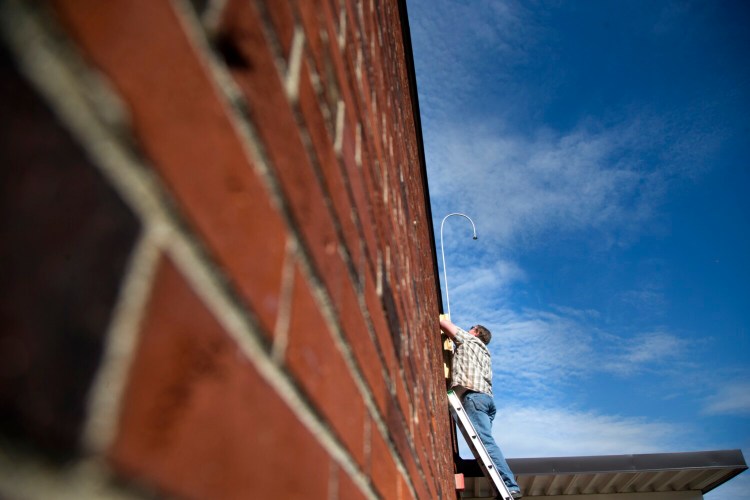SOUTH PORTLAND — A fourth air-quality monitoring station is set to begin operating Monday as part of the city’s effort to gauge the magnitude of air pollution emitted by petroleum storage facilities and other sources within and beyond city limits.
Specialists from the Maine Department of Environmental Protection installed the station last Thursday and Friday at Memorial Middle School on Wescott Road.

Laura Paye, an environmental specialist from Department of Environmental Protection, installs an air quality monitoring station at Memorial Middle School in South Portland. Derek Davis/Staff Photographer
The state agency agreed to administer the yearlong monitoring program after the U.S. Environmental Protection Agency filed a lawsuit last spring that called attention to air pollution and foul odors emitted by petroleum storage tanks and other sources across the city.
It’s the first time the DEP has established a community air quality monitoring program in addition to several permanent stations it maintains across the state – including two in Portland and one in Cape Elizabeth – which measure pollution for regular reports to the EPA.
“We’re using science to address the community’s concerns with the latest technology available,” said Liza Woodward, an environmental specialist with the DEP.
City officials decided to place a station in each of five voting districts to ensure a sense of fairness, but the stations are concentrated near the waterfront in more densely populated areas.
The middle school is in District 4, between Broadway and Route 1, on the west side of the city. Stations were installed over the summer at South Portland High School (District 3), City Hall (District 2) and Bug Light Park (District 1). A fifth station will be installed in the Redbank neighborhood (District 5).

An air quality monitoring station at Memorial Middle School is the fourth one installed in a unique citywide program. Derek Davis/Staff Photographer
The stations will sample outdoor air quality for a 24-hour period each week. The DEP is expected to update city officials on the program’s progress and issue a final report next year.
The EPA filed a lawsuit and consent decree in March charging Global Partners LP with violating the Clean Air Act at its petroleum terminal on the Fore River, off Lincoln Street, in the Pleasantdale area (District 3).
City officials and residents were shocked and upset to learn DEP staff members had known since 2011 – but never warned the city – that the EPA was targeting hazardous emissions from Global and Sprague facilities in South Portland.
In particular, the federal agency cracked down on pollution from heated tanks of asphalt and No. 6 heavy residual fuel oil. Global recently announced plans to go beyond the requirements of the consent decree to reduce odors and emissions.
Testing started in June, with the distribution of so-called “grab canisters” to volunteers who have been taking air samples wherever they smell foul odors, such as those emitted by the heated petroleum tanks.
In August, DEP officials released preliminary and inconclusive test results that indicate South Portland’s air quality is affected by its location and status as a commercial center and transportation hub on the East Coast, including emissions from boats, planes, trains and motor vehicles, as well as power plants and other polluters in states to the west.

The air quality monitoring station at Memorial Middle School will sample outdoor air quality for a 24-hour period each week. The DEP is expected to update city officials on the program’s progress and issue a final report next year. Derek Davis/Staff Photographer
Of 13 successful “grab samples” taken by volunteers across the city, significant odor and benzene spikes on Chapel Street and Skillins Street were associated with shipping activity and vehicle traffic on the city’s waterfront and trains moving through Rigby Yard, respectively. A 24-hour sample taken at the permanent monitoring station near City Hall showed a similar spike on July 26.
DEP officials have urged residents to be patient and warned that definitive results won’t be available for months and might not prove conclusive. They’ve also noted repeatedly that a foul odor doesn’t guarantee the presence of hazardous emissions and a lack of odor doesn’t mean air is clean.
Andy Johnson, the DEP’s head of ambient air monitoring, said the agency will administer the program for the city for one year starting this fall. The program is focusing on volatile organic compounds, or VOCs, which include a variety of chemicals that can produce adverse health effects such as eye, nose and throat irritation, headaches, nausea and damage to the liver, kidneys and central nervous system, the EPA said.
VOCs also contribute to the formation of ground-level ozone. Breathing ozone can trigger a variety of health problems, particularly for children, the elderly and anyone with lung diseases such as asthma. Ground-level ozone also can harm sensitive vegetation and ecosystems.
The DEP has agreed to cover the $64,400 cost of equipment and in-house testing for this phase of the program, but additional funding could expand the scope of the program to other pollutants in the future, Johnson said.
The agency is saving more than $200,000 by building the monitoring stations from component parts, including stainless steel tubing, a vacuum canister and a digital timer.
A weather gauge could be added to each station in the future so weather conditions could be factored into air quality analyses, Woodward said.
Send questions/comments to the editors.



Success. Please wait for the page to reload. If the page does not reload within 5 seconds, please refresh the page.
Enter your email and password to access comments.
Hi, to comment on stories you must . This profile is in addition to your subscription and website login.
Already have a commenting profile? .
Invalid username/password.
Please check your email to confirm and complete your registration.
Only subscribers are eligible to post comments. Please subscribe or login first for digital access. Here’s why.
Use the form below to reset your password. When you've submitted your account email, we will send an email with a reset code.